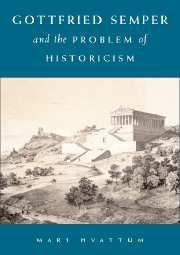Book contents
- Frontmatter
- Contents
- List of Figures
- Prolegomenon
- Introduction – Gottfried Semper: Texts and Interpretations
- PART I TOWARDS A POETICS OF ARCHITECTURE
- PART II PRACTICAL AESTHETICS
- 4 Semper and Practical Aesthetics
- 5 The Comparative Method
- 6 Towards a Method of Inventing
- PART III THE APORIAS OF HISTORICISM
- Epilogue
- Notes
- Selected Semper Bibliography
- Bibliography
- Index
5 - The Comparative Method
from PART II - PRACTICAL AESTHETICS
Published online by Cambridge University Press: 06 August 2009
- Frontmatter
- Contents
- List of Figures
- Prolegomenon
- Introduction – Gottfried Semper: Texts and Interpretations
- PART I TOWARDS A POETICS OF ARCHITECTURE
- PART II PRACTICAL AESTHETICS
- 4 Semper and Practical Aesthetics
- 5 The Comparative Method
- 6 Towards a Method of Inventing
- PART III THE APORIAS OF HISTORICISM
- Epilogue
- Notes
- Selected Semper Bibliography
- Bibliography
- Index
Summary
“In raschem Siegeslauf hat die vergleichende Methode ein Gebiet des Erkennens nach dem anderen ihrer Herrschaft unterworfen und mit wie herrlichem Erfolg.”
E. ZitelmannSemper's practical aesthetics involved several methodological steps. If the theory of formal beauty explained the ‘intrinsic coefficients’ of art, and the formula for style explained their modification by particular historical conditions, one step was still missing: a way to understand the correspondence between style and society as it unfolds through history. Missing, in other words, was an overall matrix in which individual historical moments could be coordinated into a comprehensive system of world history. If this could be achieved, it would be possible to explain the correspondence between artistic form and social-material conditions throughout history – for the first time establishing a complete and systematic science of the origin and development of art.
Looking for precedents for this ambitious project, Semper found contemporary human sciences in a deplorable state. In his view, the lack of proper methodology had made the study of man a “chaos of facts and experiences” accumulated “without coherence or principles”. To counter this confusion, Semper sought a method that could “find again those connections between the things, and … transform into an organic system of comparison what was before only an exterior and more or less arbitrary system of coordination and of exterior order.” Such a move from an ‘analytic’ to a ‘synthetic’ science, he argued, had already been achieved in a few other disciplines:
Philosophy, history, politics and a few other branches of the natural sciences were raised to [the] comparative viewpoint by the great men of the past centuries, while in the other sciences, because of the abundance and complexity of their material, inferences only timidly begin to join with research.
- Type
- Chapter
- Information
- Gottfried Semper and the Problem of Historicism , pp. 114 - 136Publisher: Cambridge University PressPrint publication year: 2004
- 2
- Cited by



